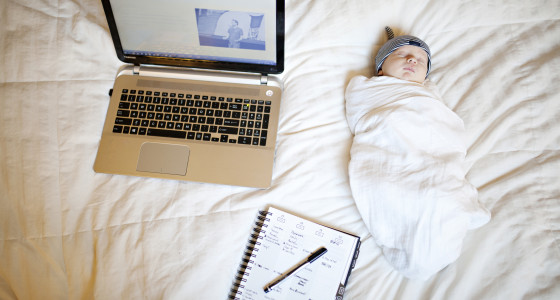
This article was last updated on 26/07/2023
According to a report by The Association of Independent Professionals and the Self-Employed, the number of freelance mums has doubled since 2008. Self-employed mums now account for one in seven of all self-employed people in the UK, with many working as highly-skilled freelancers.
There’s little wonder that self-employment’s an attractive prospect for parents. In theory, it can offer better pay, more flexible hours, and the chance to work from home. But what about taking time off to have a baby? As self-employed mums don’t receive Statutory Maternity Pay (SMP), the idea of taking maternity leave can be daunting.
Our guide will help you get to grips with the financial help that is available to self-employed mums, and run through some steps you can take to make mat leave more affordable.
Maternity pay for freelancers
While employed mums tend to be eligible for SMP, the equivalent for self-employed mums is Maternity Allowance (MA). If you’re eligible for the full amount of MA, you’ll currently receive £172.48 a week, or 90% of your average weekly earnings (whichever is the lower amount) for 39 weeks.
To receive this, you need to have been working for at least 26 weeks in the 66 weeks before your baby’s due date, with average gross weekly earnings of at least £30 for at least 13 weeks.
If you don’t qualify for the full amount, you may be able to get a reduced amount of £27 a week instead. You can use the government’s maternity pay calculator to check what you might receive. You can also find the MA claim form on the government’s website.
Happily, MA isn’t taxable. Unhappily, there’s no equivalent for dads: self-employed dads who want to take time off to look after their baby don’t receive any government help, so generally have to rely on savings instead.
Freelancing during maternity leave
If you’re a freelancer receiving MA, you’re allowed to work (and be paid for) up to 10 “Keeping in Touch” (KIT) days while you’re on maternity leave, just like employed mums receiving SMP. This gives you the chance to stay in contact with your clients while you’re off, keep your business ticking over, and ease yourself back into work as your leave nears an end. Ten days of paid work can helpfully boost your income while you’re on maternity leave, but bear in mind that if you work more than 10 days, you’ll lose your entitlement to MA.
Things are a little different if you’re an employee who dabbles in freelance work on the side. While you’re on maternity leave from your permanent job, you can do as much self-employed work for other companies (i.e. not your regular employer) as you like without affecting your SMP.
Financial help with having a baby
As this can be a tight time financially, it’s worth making the most of the perks that are available. Just like employed mums, self-employed women are entitled to free NHS dental care and free prescriptions during pregnancy and for up to a year after the baby’s birth.
If you’re a first-time mum and you receive certain benefits, you may also be eligible for the Sure Start Maternity Grant, which is a one-off payment of £500 towards the costs of having a child.
And don’t forget to claim Child Benefit, which is currently £24 per week for your first child and £15.90 for subsequent children. This benefit isn’t means-tested, although if you (or your partner) earn over £50,000 after tax then you have to pay a tax charge. This may mean that you don’t want to claim Child Benefit, but you should fill in the form anyway to protect your National Insurance credits and therefore your State Pension entitlement.
Pension saving during maternity leave
Saving for your pension while you’re on maternity leave can be difficult, especially if you’re self-employed. When you stop working to look after your baby, you may not be able to maintain your usual level of pension contributions. If this is the case, remember that you can top up your pension once you’re working again so that you don’t get behind with your retirement saving.
If you don’t have a private pension, our Pensions 101 video on self-employed pensions and our self-employed pension plan can help you to start saving.
Top money management tips
Self-employed and planning a pregnancy or expecting a baby? Take these steps now to get your finances in shape.
Now’s the time to chase up any unpaid invoices! This will save you the hassle once you’re on maternity leave, and hopefully give your bank balance a boost before you stop working.
If there’s a tax return deadline looming, get your books in order as soon as possible so that you’re not hunting down receipts while caring for your newborn. Check out our self-employed tax tips.
Make a new household budget that takes into account your changes in income and expenditure.
See if you can get things like cots, clothes and toys second-hand, either from friends and family or from “nearly new” sales.
Hold off buying the latest gadgets and accessories until your baby arrives and you actually know what you really need.
Consider reusable nappies to save both the environment and your pennies!
Be aware of childcare options and costs so that you can make “return to work” calculations when the time comes.
Risk warning
As always with investments, your capital is at risk. The value of your investment can go down as well as up, and you may get back less than you invest. This information should not be regarded as financial advice.




